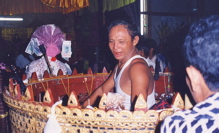Music Of Nat Pwe: Folk And Pop Music Of Myanmar Vol. 3
 Burma (or Myanmar, depending on who you talk to) has been in the news lately, and the country’s music is fascinating, especially from a percussion standpoint. Last week we posted a review of Princess Nicotine: Folk And Pop Music Of Myanmar, a collection of music recorded by The Sun City Girls’ Alan Bishop for his Sublime Frequencies label. In that review we promised to bring you Alan’s impressions of a specific style of Burmese music called Nat Pwe, as presented on the Sublime Frequencies CD Music Of Nat Pwe: Folk And Pop Music Of Myanmar Vol. 3. Alan was kind enough to answer a few specific questions MD had after hearing this captivating disc.
Burma (or Myanmar, depending on who you talk to) has been in the news lately, and the country’s music is fascinating, especially from a percussion standpoint. Last week we posted a review of Princess Nicotine: Folk And Pop Music Of Myanmar, a collection of music recorded by The Sun City Girls’ Alan Bishop for his Sublime Frequencies label. In that review we promised to bring you Alan’s impressions of a specific style of Burmese music called Nat Pwe, as presented on the Sublime Frequencies CD Music Of Nat Pwe: Folk And Pop Music Of Myanmar Vol. 3. Alan was kind enough to answer a few specific questions MD had after hearing this captivating disc.
What are some of the basic instruments used in this music?
The main instrument is called the Hsaing Waing, or circle drum. It’s a circular structure containing a series of tuned melodic drums, which line the inside of the structure for 360° around. The drums are either played by hand or with mallets. The heads of the drums can be made from animal skin, metal, or rubber. The Hsaing Waing usually drives the melody of the song with the oboe (similar to the chenai from India) and the vocalist. Each drum circle seems to be customized and maintained by the drummer who usually occupies it.
How many people are playing at any given time?
The Nat Pwe orchestra is a slight variation of the orchestra used in Burmese classical music. There is the Hsaing Waing player at the center of the orchestra, one or two oboe players, one or two vocalists along with chorus vocals handled by the other musicians, several hand drums, and several miscellaneous percussion instruments like xylophone, hand cymbals, wood blocks, bells, beds of nipple gongs, or weirder homemade percussion instruments. All together, a typical Nat Pwe orchestra consists of eight to twelve people.
Advertisement
Does each musician play only one instrument?
Yes, each musician is responsible for his instrument only.
Are the parts very defined?
At times the parts are frighteningly precise and awe-inspiringly complex in terms of composition and execution. There are many improbable sequences, changes, and oddly arranged passages. Then there is the tremendous speed with which pieces are sometimes executed, making them all the more impressive. At other times there seems to be no perceptible order for a period of the time, only for it to come back to that precisely executed coherence from out of nowhere to put things back in perspective.
 Is there improv involved?
Is there improv involved?
Yes, the veteran musicians are free to improvise throughout the songs, as long as they execute the most important form elements and proper areas of emphasis for the said piece. From this improvisation come highly unique polyrhythmic segments, solos by the oboe, vocal improvisations, and other more serendipitous discoveries that occur in collective improvisation. The main director of the orchestra is the circle drum player, who is responsible for guiding the music. Also, the members of the audience can suddenly become possessed by the Nat spirit and begin to move unpredictably around the stage and surrounding areas creating, another element of spontaneity.
What types of rhythms are typical?
The rhythms are normally based in common time, and many of the songs can be repetitive for spells. But there are many tempo changes, breaks, and polyrhythmic segments.
Advertisement
Are there clear influences from other cultures?
This is a question I’ve been trying to answer for many years. Geographically, Burma (Myanmar) is surrounded by some major cultural heavyweights: China, India, and Thailand. Yet, the many musical traditions developed in Burma–from the solo piano stylings, to the very unique sound of the Burmese harp, to the Hsaing Waing orchestra of Nat Pwe and Burmese classical music–seem to be developed on their own without much or very little revelation of any outside influences whatsoever. In other words, nothing anywhere really sounds like Burmese music. From everything I’ve read on the subject over the years, Thai music and Indian music are sometimes referenced as influential, but I’ve never heard any Thai or Indian music that sounds quite like traditional Burmese music. They seem to have somehow developed a system of operation with whatever they have incorporated from beyond their borders that simply pioneers new directions in music, and the outside world is barely aware of this fact. Burmese popular music has many obvious influences, especially from the West, but this is the norm everywhere.
To learn more about Music Of Nat Pwe and a wellspring of other world-music CDs and DVDs, go to www.sublimefrequencies.com. Their products are also available at many progressive online and brick & mortar dealers around the world.


